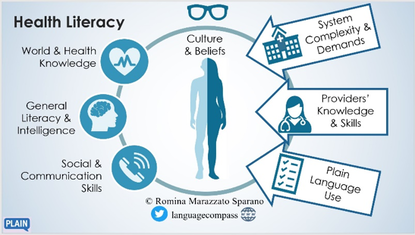I am so excited to announce that I have partnered with Plain Language academy to teach my new course Plain Language 2.0 and Health Literacy. In case you didn’t know, Plain Language Academy is a training hub for all things plain language founded by eloquent Kate Harrison Whiteside.
The new course is coming March 2nd 2020. Find out more.
Here’s a little bit about what I’ll cover:
Health literacy is defined as the ability to find, understand, and process information to make healthcare decisions. But this definition is changing. The concern is that success in health communication does not only hinge upon an individual’s ability, but also on the accessibility, clarity, and actionability of health information and services offered.

A wider understanding of health literacy sees it as a multidimensional construct that enables successful health communication. Health literacy is, then, the set of world and health knowledge, general intelligence and literacy, and social and communication skills that allow an individual to seek, obtain, understand, assess, and apply health information in daily life and health care contexts. This ability is mediated by:
- the individual’s culture and beliefs, including education and language;
- the knowledge, intelligence, literacy, communication skills, culture, and beliefs of health care and health information providers;
- the demands and complexities of the healthcare system
- the use of plain language in communication.
Health communication includes patients, providers, and caregivers, and often takes place in distressing or time-sensitive situations. Plain language has a vital role to play in aligning audiences, providers, and situations to produce better health outcomes. Health care and health information providers have a responsibility to provide information in plain language, that is, in clear and accessible language.
This responsibility is also now promoted and even required through laws and regulations that “see” the benefits of plain language. One such regulation is the European Union Clinical Trials Regulation (EU CTR 536/2014) which includes a requirement for the submission of lay summaries to promote trust, partnership, and patient engagement. Another example: US hospitals now face financial penalties for high readmission rates, so they are turning to plain language in an effort to reduce re-hospitalization due to poor communication.
In the new course, Plain Language 2.0 and Health Literacy, we will explore health literacy and how it can be improved. Considering text production in the wider context of health communication, we will focus on plain language strategies for clarity and accessibility. We will distinguish between strategies for textuality and strategies for adequacy. Textuality refers to how grammar, cohesion, and coherence create meaning in technical and lay texts. Adequacy refers to how register, style, and design inform the suitability of the text for the purpose and audience at hand.
